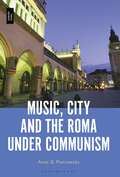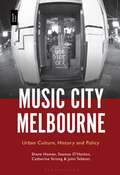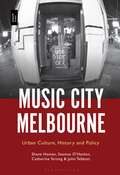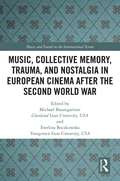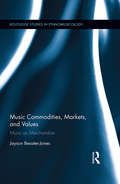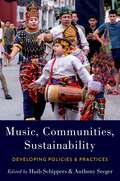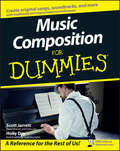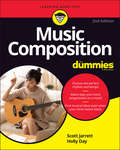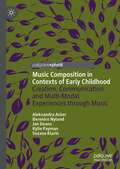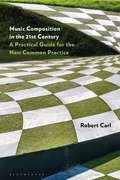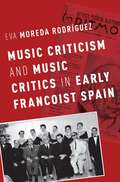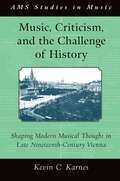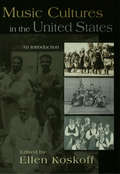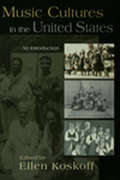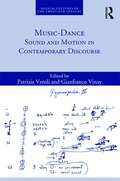- Table View
- List View
Music, City and the Roma under Communism
by Anna G. PiotrowskaThis book highlights the role of Romani musical presence in Central and Eastern Europe, especially from Krakow in the Communist period, and argues that music can and should be treated as one of the main points of relation between Roma and non-Roma. It discusses Romani performers and the complexity of their situation as conditioned by the political situations starkly affected by the Communist regime, and then by its fall. Against this backdrop, the book engages with musician Stefan Dymiter (known as Corroro) as the leader of his own street band: unwelcome in the public space by the authorities, merely tolerated by others, but admired by many passers-by and respected by his peer Romain musicians and international music stars. It emphasizes the role of Romani musicians in Krakow in shaping the soundscape of the city while also demonstrating their collective and individual strategies to adapt to the new circumstances in terms of the preferred performative techniques, repertoire, and overall lifestyle.
Music City Melbourne: Urban Culture, History and Policy
by Shane Homan Seamus O’Hanlon Catherine Strong John TebbuttHow did Melbourne earn its place as one of the world's 'music cities'? Beginning with the arrival of rock 'n' roll in the 1950s, this book explores the development of different sectors of Melbourne's popular music ecosystem in parallel with broader population, urban planning and media industry changes in the city. The authors draw on interviews with Melbourne musicians, venue owners and policy-makers, documenting their ambitions and experiences across different periods, with accompanying spotlights on the gendered, multicultural and indigenous contexts of playing and recording in Melbourne. Focusing on pop and rock, this is the first book to provide an extensive historical lens of popular music within an urban cultural economy that in turn investigates the contemporary nature and challenges of urban music activities and policy.
Music City Melbourne: Urban Culture, History and Policy
by Shane Homan Seamus O’Hanlon Catherine Strong John TebbuttHow did Melbourne earn its place as one of the world's 'music cities'? Beginning with the arrival of rock 'n' roll in the 1950s, this book explores the development of different sectors of Melbourne's popular music ecosystem in parallel with broader population, urban planning and media industry changes in the city. The authors draw on interviews with Melbourne musicians, venue owners and policy-makers, documenting their ambitions and experiences across different periods, with accompanying spotlights on the gendered, multicultural and indigenous contexts of playing and recording in Melbourne. Focusing on pop and rock, this is the first book to provide an extensive historical lens of popular music within an urban cultural economy that in turn investigates the contemporary nature and challenges of urban music activities and policy.
Music, Collective Memory, Trauma, and Nostalgia in European Cinema after the Second World War (Music and Sound on the International Screen)
by Michael Baumgartner Ewelina BoczkowskaIn the wake of World War II, the arts and culture of Europe became a site where the devastating events of the 20th century were remembered and understood. Exploring one of the most integral elements of the cinematic experience—music—the essays in this volume consider the numerous ways in which post-war European cinema dealt with memory, trauma and nostalgia, showing how the music of these films shaped the representation of the past. The contributors consider films from the United Kingdom, Poland, the Soviet Union, France, Italy, Germany, Sweden, Austria, and the Netherlands, providing a diverse and well-rounded understanding of film music in the context of historical memory. Memory is often underrepresented within scholarly musical studies, with most of these applications found in the disciplines of ethnomusicology, popular music studies, music cognition, and psychology and music therapy. Likewise, trauma has mainly been studied in relation to music in only a few historical contexts, while nostalgia has attracted even less academic attention. In three parts, this volume addresses each area of study as it relates to the music of European cinema from 1945 to 1989, applying an interdisciplinary approach to investigate how films use music to negotiate the precarious relationships we maintain with the past. Music, Collective Memory, Trauma, and Nostalgia in European Cinema after the Second World War offers compelling arguments as to what makes music such a powerful medium for memory, trauma and nostalgia.
Music, Collective Memory, Trauma, and Nostalgia in European Cinema after the Second World War (Music and Sound on the International Screen)
by Michael Baumgartner Ewelina BoczkowskaIn the wake of World War II, the arts and culture of Europe became a site where the devastating events of the 20th century were remembered and understood. Exploring one of the most integral elements of the cinematic experience—music—the essays in this volume consider the numerous ways in which post-war European cinema dealt with memory, trauma and nostalgia, showing how the music of these films shaped the representation of the past. The contributors consider films from the United Kingdom, Poland, the Soviet Union, France, Italy, Germany, Sweden, Austria, and the Netherlands, providing a diverse and well-rounded understanding of film music in the context of historical memory. Memory is often underrepresented within scholarly musical studies, with most of these applications found in the disciplines of ethnomusicology, popular music studies, music cognition, and psychology and music therapy. Likewise, trauma has mainly been studied in relation to music in only a few historical contexts, while nostalgia has attracted even less academic attention. In three parts, this volume addresses each area of study as it relates to the music of European cinema from 1945 to 1989, applying an interdisciplinary approach to investigate how films use music to negotiate the precarious relationships we maintain with the past. Music, Collective Memory, Trauma, and Nostalgia in European Cinema after the Second World War offers compelling arguments as to what makes music such a powerful medium for memory, trauma and nostalgia.
Music Commodities, Markets, and Values: Music as Merchandise (Routledge Studies in Ethnomusicology)
by Jayson Beaster-JonesThis book examines music stores as sites of cultural production in contemporary India. Analyzing social practices of selling music in a variety of retail contexts, it focuses upon the economic and social values that are produced and circulated by music retailers in the marketplace. Based upon research conducted over a volatile ten-year period of the Indian music industry, Beaster-Jones discusses the cultural histories of the recording industry, the social changes that have accompanied India’s economic liberalization reforms, and the economic realities of selling music in India as digital circulation of music recordings gradually displaced physical distribution. The volume considers the mobilization of musical, economic, and social values as a component of branding discourses in neoliberal India, as a justification for new regimes of legitimate use and intellectual property, as a scene for the performance of cosmopolitanism by shopping, and as a site of anxiety about transformations in the marketplace. It relies upon ethnographic observation and interviews from a variety of sources within the Indian music industry, including perspectives of executives at music labels, family-run and corporate music stores, and hawkers in street markets selling counterfeit recordings. This ethnography of the practices, spaces, and anxieties of selling music in urban India will be an important resource for scholars in a wide range of fields, including ethnomusicology, anthropology, popular music studies, and South Asian studies.
Music Commodities, Markets, and Values: Music as Merchandise (Routledge Studies in Ethnomusicology)
by Jayson Beaster-JonesThis book examines music stores as sites of cultural production in contemporary India. Analyzing social practices of selling music in a variety of retail contexts, it focuses upon the economic and social values that are produced and circulated by music retailers in the marketplace. Based upon research conducted over a volatile ten-year period of the Indian music industry, Beaster-Jones discusses the cultural histories of the recording industry, the social changes that have accompanied India’s economic liberalization reforms, and the economic realities of selling music in India as digital circulation of music recordings gradually displaced physical distribution. The volume considers the mobilization of musical, economic, and social values as a component of branding discourses in neoliberal India, as a justification for new regimes of legitimate use and intellectual property, as a scene for the performance of cosmopolitanism by shopping, and as a site of anxiety about transformations in the marketplace. It relies upon ethnographic observation and interviews from a variety of sources within the Indian music industry, including perspectives of executives at music labels, family-run and corporate music stores, and hawkers in street markets selling counterfeit recordings. This ethnography of the practices, spaces, and anxieties of selling music in urban India will be an important resource for scholars in a wide range of fields, including ethnomusicology, anthropology, popular music studies, and South Asian studies.
Music, Communities, Sustainability: Developing Policies and Practices
by Huib Schippers and Anthony SeegerMusic, Communities, Sustainability, edited thoughtfully by Huib Schippers and Anthony Seeger, traces the genesis, implementation, and development of the influential 2003 UNESCO Convention on Safeguarding of the Intangible Cultural Heritage and its impact on music practices around the world. With insights from established and emerging scholars who have been there from the early beginnings to those who work with it in communities today, this book tells a riveting story that celebrates the rise in awareness that approaching music as Intangible Cultural Heritage has brought. At the same time, it critiques the discrepancies between ideologies and realities as they emerged across the globe in its first twenty years, and provides perspectives for sound futures for the planet. Gathering such varied perspectives, this essential volume tells a crucial history and expands our understanding of the possibilities and limitations of interventions in music sustainability on a global scale.
Music, Communities, Sustainability: Developing Policies and Practices
Music, Communities, Sustainability, edited thoughtfully by Huib Schippers and Anthony Seeger, traces the genesis, implementation, and development of the influential 2003 UNESCO Convention on Safeguarding of the Intangible Cultural Heritage and its impact on music practices around the world. With insights from established and emerging scholars who have been there from the early beginnings to those who work with it in communities today, this book tells a riveting story that celebrates the rise in awareness that approaching music as Intangible Cultural Heritage has brought. At the same time, it critiques the discrepancies between ideologies and realities as they emerged across the globe in its first twenty years, and provides perspectives for sound futures for the planet. Gathering such varied perspectives, this essential volume tells a crucial history and expands our understanding of the possibilities and limitations of interventions in music sustainability on a global scale.
Music Composition For Dummies
by Scott Jarrett Holly DayWant to turn that haunting tune in your head into an awesome sound in your ear? You can! Music Composition For Dummies demystifies the process of composing music and writing songs. It guides you through every step of writing your own music, from choosing the right rhythm and tempo to creating melodies and chord progressions and working with instruments and voices. In this fun and practical guide, you’ll learn how to match keys and chords to the mood you want to convey, work a form without limiting your creativity, and hammer out a musical idea, even when your mind is drawing a blank. You’ll find out how to create popular songs, classically structured pieces, and even film, TV, and video game soundtracks. And, you’ll learn what you need to know about music composition software, including Finale, Sebelius, Pro Tools, and more. Discover how to: Preserve and organize your musical ideas Work with established chord progressions or create your own Develop great rhythms Select the right instruments Find melodies in your head, your instrument, and the world around you Use major and minor scales Work with modes and moods Build melodic motifs and phrases Use the circle of fifths to harmonize Write for multiple voices Make a demo recording Filled with creative exercises to build your composing skills, Music Composition for Dummies is the resource you need to get that melody out of your head and into the world.
Music Composition For Dummies
by Scott Jarrett Holly DayYou can hum it, but can you write it down? When most people think of a composer, they picture a bewigged genius like Mozart or Beethoven frenetically directing mighty orchestras in the ornate palaces of Vienna. While that may have been the case once upon a time, modern composers make themselves heard far beyond the classical conservatoire and concert hall. These days, soundtracks are in high demand in industries such as TV, film, advertising, and even gaming to help create immersive and exciting experiences. Whatever your musical ambitions—composing a dark requiem in a beautiful Viennese apartment or producing the next great Star Wars-like movie theme in LA—the fully updated Music Composition For Dummies hits all the right notes to help you become confident in the theory and practice of composition. To help you translate your musical ideas from fleeting tunes in your head to playable bars and notation on paper, professional composer and instructor Scott Jarrett and music journalist Holly Day take you on a friendly step-by-step journey through the process of musical creation, including choosing the right rhythms and tempos, creating melodies and chord progressions, and working with instruments and voices. You’ll learn how to match keys and chords to mood, use form to enhance your creativity, and write in different styles from pop to classical—and you’ll even learn how to keep hammering away when inspiration eludes you. Organize and preserve your musical ideas Formalize your knowledge with professional vocabulary Get familiar with composition apps and software Make a demo and market on social media Filled with musical exercises to help you acquire the discipline you need for success, Music Composition For Dummies has everything you need to turn your inner soundtrack into a tuneful reality!
Music Composition For Dummies
by Scott Jarrett Holly DayYou can hum it, but can you write it down? When most people think of a composer, they picture a bewigged genius like Mozart or Beethoven frenetically directing mighty orchestras in the ornate palaces of Vienna. While that may have been the case once upon a time, modern composers make themselves heard far beyond the classical conservatoire and concert hall. These days, soundtracks are in high demand in industries such as TV, film, advertising, and even gaming to help create immersive and exciting experiences. Whatever your musical ambitions—composing a dark requiem in a beautiful Viennese apartment or producing the next great Star Wars-like movie theme in LA—the fully updated Music Composition For Dummies hits all the right notes to help you become confident in the theory and practice of composition. To help you translate your musical ideas from fleeting tunes in your head to playable bars and notation on paper, professional composer and instructor Scott Jarrett and music journalist Holly Day take you on a friendly step-by-step journey through the process of musical creation, including choosing the right rhythms and tempos, creating melodies and chord progressions, and working with instruments and voices. You’ll learn how to match keys and chords to mood, use form to enhance your creativity, and write in different styles from pop to classical—and you’ll even learn how to keep hammering away when inspiration eludes you. Organize and preserve your musical ideas Formalize your knowledge with professional vocabulary Get familiar with composition apps and software Make a demo and market on social media Filled with musical exercises to help you acquire the discipline you need for success, Music Composition For Dummies has everything you need to turn your inner soundtrack into a tuneful reality!
Music Composition in Contexts of Early Childhood: Creation, Communication and Multi-Modal Experiences through Music
by Jan Deans Berenice Nyland Aleksandra Acker Kylie Payman Suzana KlarinThis book explores the narratives of a group of four-year-old children in a composition project in an Australian early learning centre. The participants, centre staff and a composer, Stephen Leek, contributed a number of music sessions for the children, including five original songs. The book showcases young children’s communicative ability and sensitivity to wider issues. The staff in the centre have a strongly voiced philosophy that is enacted through arts-based pedagogy and incorporates significant themes including a respect for Aboriginal culture and custodial responsibility towards a sustainable future for the earth. Examples of adult and children’s ideas are illustrated through music making, singing, dancing, words, drawings and paintings, which provide insights into a world where children are viewed as active citizens and the arts have rights. The book describes the context of the centre, the history of projects and details one project as an example of “lifeworthy learning”.
Music Composition in the 21st Century: A Practical Guide for the New Common Practice
by Robert CarlThe state of contemporary music is dizzyingly diverse in terms of style, media, traditions, and techniques. How have trends in music developed over the past decades? Music Composition in the 21st Century is a guide for composers and students that helps them navigate the often daunting complexity and abundance of resources and influences that confront them as they work to achieve a personal expression.From pop to classical, the book speaks to the creative ways that new composers mix and synthesize music, creating a music that exists along a more continuous spectrum rather than in a series of siloed practices. It pays special attention to a series of critical issues that have surfaced in recent years, including harmony, the influence of minimalism, the impact of technology, strategies of "openness," sound art, collaboration, and improvisation. Robert Carl identifies an emerging common practice that allows creators to make more informed aesthetic and technical decisions and also fosters an inherently positive approach to new methods.
Music Composition in the 21st Century: A Practical Guide for the New Common Practice
by Robert CarlThe state of contemporary music is dizzyingly diverse in terms of style, media, traditions, and techniques. How have trends in music developed over the past decades? Music Composition in the 21st Century is a guide for composers and students that helps them navigate the often daunting complexity and abundance of resources and influences that confront them as they work to achieve a personal expression.From pop to classical, the book speaks to the creative ways that new composers mix and synthesize music, creating a music that exists along a more continuous spectrum rather than in a series of siloed practices. It pays special attention to a series of critical issues that have surfaced in recent years, including harmony, the influence of minimalism, the impact of technology, strategies of "openness," sound art, collaboration, and improvisation. Robert Carl identifies an emerging common practice that allows creators to make more informed aesthetic and technical decisions and also fosters an inherently positive approach to new methods.
Music Criticism and Music Critics in Early Francoist Spain (Currents in Latin American and Iberian Music)
by Eva Moreda RodriguezThe early years of the Franco regime saw the formation of a strong governmental propaganda apparatus. Through expansive press laws that solidified state control over public and private media outlets alike, the Franco government directly influenced what information was made available to the public. While music critics and journalists were by no means free from government control and direction, music criticism under the Franco regime did not adhere to any official party "line" on music. Indeed, music criticism often demonstrated a diversity of opinion and ideological belief that runs counter to many common assumptions about journalism under fascist regimes. In Music Criticism and Music Critics in Early Francoist Spain, Eva Moreda Rodríguez presents a kaleidoscopic portrait of the diverse and often divergent writings of music critics in the early years of the Franco regime. Although she does not shy away from the thorny issues of propaganda and censorship, Moreda Rodríguez considers other factors that shaped the journalistic discourse surrounding music. Political rivalries, ideological diversity within musical "conservatism," as well as the explicit and implicit expectations of the Franco government all influenced the diverse landscape of music criticism. Moreover, the central issues that music critics were concerned with during Francoism's early years-modernist music, Spanish early music, traditional music, and music's role in organizing the state-had already been at the center of debates within the press for several decades. Carefully selecting contemporary writings by well-known music critics, Moreda Rodríguez contextualizes music criticism written during the Franco regime within the broader intellectual history of Spain from the nineteenth century onwards. The first critical study of the musical press of Francoist Spain in the broader cultural and social fabric of the regime, Music Criticism and Music Critics in Early Francoist Spain is an essential resource for musicologists interested in 20th-century Spain, as well as Hispanists interested in the early Franco regime.
Music Criticism and Music Critics in Early Francoist Spain (Currents in Latin American and Iberian Music)
by Eva Moreda RodriguezThe early years of the Franco regime saw the formation of a strong governmental propaganda apparatus. Through expansive press laws that solidified state control over public and private media outlets alike, the Franco government directly influenced what information was made available to the public. While music critics and journalists were by no means free from government control and direction, music criticism under the Franco regime did not adhere to any official party "line" on music. Indeed, music criticism often demonstrated a diversity of opinion and ideological belief that runs counter to many common assumptions about journalism under fascist regimes. In Music Criticism and Music Critics in Early Francoist Spain, Eva Moreda Rodríguez presents a kaleidoscopic portrait of the diverse and often divergent writings of music critics in the early years of the Franco regime. Although she does not shy away from the thorny issues of propaganda and censorship, Moreda Rodríguez considers other factors that shaped the journalistic discourse surrounding music. Political rivalries, ideological diversity within musical "conservatism," as well as the explicit and implicit expectations of the Franco government all influenced the diverse landscape of music criticism. Moreover, the central issues that music critics were concerned with during Francoism's early years-modernist music, Spanish early music, traditional music, and music's role in organizing the state-had already been at the center of debates within the press for several decades. Carefully selecting contemporary writings by well-known music critics, Moreda Rodríguez contextualizes music criticism written during the Franco regime within the broader intellectual history of Spain from the nineteenth century onwards. The first critical study of the musical press of Francoist Spain in the broader cultural and social fabric of the regime, Music Criticism and Music Critics in Early Francoist Spain is an essential resource for musicologists interested in 20th-century Spain, as well as Hispanists interested in the early Franco regime.
Music, Criticism, and the Challenge of History: Shaping Modern Musical Thought in Late Nineteenth Century Vienna (AMS Studies in Music)
by Kevin KarnesMore than a century after Guido Adler's appointment to the first chair in musicology at the University of Vienna, Music, Criticism, and the Challenge of History provides a first look at the discipline in this earliest period, and at the ideological dilemmas and methodological anxieties that characterized it upon its institutionalization. Author Kevin Karnes contends that some of the most vital questions surrounding musicology's disciplinary identities today-the relationship between musicology and criticism, the role of the subject in analysis and the narration of history, and the responsibilities of the scholar to the listening public-originate in these conflicted and largely forgotten beginnings. Karnes lays bare the nature of music study in the late nineteenth century through insightful readings of long-overlooked contributions by three of musicology's foremost pioneers-Adler, Eduard Hanslick, and Heinrich Schenker. Shaped as much by the skeptical pronouncements of the likes of Nietzsche and Wagner as it was by progressivist ideologies of scientific positivism, the new discipline comprised an array of oft-contested and intensely personal visions of music study, its value, and its future. Karnes introduces readers to a Hanslick who rejected the call of positivist scholarship and dedicated himself to penning an avowedly subjective history of Viennese musical life. He argues that Schenker's analytical experiments had roots in a Wagner-inspired search for a critical alternative to Adler's style-obsessed scholarship. And he illuminates Adler's determined response to Nietzsche's warnings about the vitality of artistic and cultural life in an increasingly scientific age. Through sophisticated and meticulous presentation, Music, Criticism, and the Challenge of History demonstrates that the new discipline of musicology was inextricably tied in with the cultural discourse of its time.
Music, Criticism, and the Challenge of History: Shaping Modern Musical Thought in Late Nineteenth Century Vienna (AMS Studies in Music)
by Kevin KarnesMore than a century after Guido Adler's appointment to the first chair in musicology at the University of Vienna, Music, Criticism, and the Challenge of History provides a first look at the discipline in this earliest period, and at the ideological dilemmas and methodological anxieties that characterized it upon its institutionalization. Author Kevin Karnes contends that some of the most vital questions surrounding musicology's disciplinary identities today-the relationship between musicology and criticism, the role of the subject in analysis and the narration of history, and the responsibilities of the scholar to the listening public-originate in these conflicted and largely forgotten beginnings. Karnes lays bare the nature of music study in the late nineteenth century through insightful readings of long-overlooked contributions by three of musicology's foremost pioneers-Adler, Eduard Hanslick, and Heinrich Schenker. Shaped as much by the skeptical pronouncements of the likes of Nietzsche and Wagner as it was by progressivist ideologies of scientific positivism, the new discipline comprised an array of oft-contested and intensely personal visions of music study, its value, and its future. Karnes introduces readers to a Hanslick who rejected the call of positivist scholarship and dedicated himself to penning an avowedly subjective history of Viennese musical life. He argues that Schenker's analytical experiments had roots in a Wagner-inspired search for a critical alternative to Adler's style-obsessed scholarship. And he illuminates Adler's determined response to Nietzsche's warnings about the vitality of artistic and cultural life in an increasingly scientific age. Through sophisticated and meticulous presentation, Music, Criticism, and the Challenge of History demonstrates that the new discipline of musicology was inextricably tied in with the cultural discourse of its time.
Music Cultures in the United States: An Introduction
by Ellen KoskoffMusic Cultures in the United States is a basic textbook for an Introduction to American Music course. Taking a new, fresh approach to the study of American music, it is divided into three parts. In the first part, historical, social, and cultural issues are discussed, including how music history is studied; issues of musical and social identity; and institutions and processes affecting music in the U.S. The heart of the book is devoted to American musical cultures: American Indian; European; African American; Latin American; and Asian American. Each cultural section has a basic introductory article, followed by case studies of specific musical cultures. Finally, global musics are addressed, including Classical Musics and Popular Musics, as they have been performed in the U.S..Each article is written by an expert in the field, offering in-depth, knowledgeable, yet accessible writing for the student. The accompanying CD offers musical examples tied to each article. Pedagogic material includes chapter overviews, questions for study, and a chronoloogy of key musical events in American music and definitions in the margins.
Music Cultures in the United States: An Introduction
by Ellen KoskoffMusic Cultures in the United States is a basic textbook for an Introduction to American Music course. Taking a new, fresh approach to the study of American music, it is divided into three parts. In the first part, historical, social, and cultural issues are discussed, including how music history is studied; issues of musical and social identity; and institutions and processes affecting music in the U.S. The heart of the book is devoted to American musical cultures: American Indian; European; African American; Latin American; and Asian American. Each cultural section has a basic introductory article, followed by case studies of specific musical cultures. Finally, global musics are addressed, including Classical Musics and Popular Musics, as they have been performed in the U.S..Each article is written by an expert in the field, offering in-depth, knowledgeable, yet accessible writing for the student. The accompanying CD offers musical examples tied to each article. Pedagogic material includes chapter overviews, questions for study, and a chronoloogy of key musical events in American music and definitions in the margins.
Music-Dance: Sound and Motion in Contemporary Discourse (Musical Cultures of the Twentieth Century)
by Patrizia Veroli Gianfranco VinayMusic-Dance explores the identity of choreomusical work, its complex authorship and its modes of reception as well as the cognitive processes involved in the reception of dance performance. Scholars of dance and music analyse the ways in which a musical score changes its prescriptive status when it becomes part of a choreographic project, the encounter between sound and motion on stage, and the intersection of listening and seeing. As well as being of interest to musicologists and choreologists considering issues such as notation, multimedia and the analysis of performance, this volume will appeal to scholars interested in applied research in the fields of cognition and neuroscience. The line-up of authors comprises representative figures of today’s choreomusicology, dance historians, scholars of twentieth-century composition and specialists in cognitive science and performance studies. Among the topics covered are multimedia and the analysis of performance; the notational practice of choreographers and the parallel attempts of composers to find a graphic representation for musical gestures; and the experience of dance as a paradigm for a multimodal perception, which is investigated in terms of how the association of sound and movement triggers emotions and specific forms of cognition.
Music-Dance: Sound and Motion in Contemporary Discourse (Musical Cultures of the Twentieth Century)
by Patrizia Veroli Gianfranco VinayMusic-Dance explores the identity of choreomusical work, its complex authorship and its modes of reception as well as the cognitive processes involved in the reception of dance performance. Scholars of dance and music analyse the ways in which a musical score changes its prescriptive status when it becomes part of a choreographic project, the encounter between sound and motion on stage, and the intersection of listening and seeing. As well as being of interest to musicologists and choreologists considering issues such as notation, multimedia and the analysis of performance, this volume will appeal to scholars interested in applied research in the fields of cognition and neuroscience. The line-up of authors comprises representative figures of today’s choreomusicology, dance historians, scholars of twentieth-century composition and specialists in cognitive science and performance studies. Among the topics covered are multimedia and the analysis of performance; the notational practice of choreographers and the parallel attempts of composers to find a graphic representation for musical gestures; and the experience of dance as a paradigm for a multimodal perception, which is investigated in terms of how the association of sound and movement triggers emotions and specific forms of cognition.
Music-dance: Sound and Motion in Contemporary Discourse (Musical Cultures Of The Twentieth Century Ser.)
by Patrizia Veroli Gianfranco VinayAnalyses of choreomusical relationships in works for the stage usually deal with pre-existing music, in which the choreography follows the music – or even the score – and the dance is based on the music. Dancing without any music or only percussion played by other dancers as an accompaniment was the beginning of the emancipation of dance. The relationship between the dance and music is one of co-existence, that is, being related simply because they exist at the same time. If composition and choreography are created by the same person, one tends to assume an especially tight relationship between music and dance. In 1958, a dancer conducted a piano concerto. In 2005, musicians performed a composition without playing their instruments. Regarding the aesthetic versus the functional – can we still consider the aesthetic gesture as dance and the functional gesture as producing music? Where are the borders between these two performing arts? And how do they relate to each other?.
Music-dance: Sound and Motion in Contemporary Discourse (Musical Cultures Of The Twentieth Century Ser.)
by Patrizia Veroli Gianfranco VinayAnalyses of choreomusical relationships in works for the stage usually deal with pre-existing music, in which the choreography follows the music – or even the score – and the dance is based on the music. Dancing without any music or only percussion played by other dancers as an accompaniment was the beginning of the emancipation of dance. The relationship between the dance and music is one of co-existence, that is, being related simply because they exist at the same time. If composition and choreography are created by the same person, one tends to assume an especially tight relationship between music and dance. In 1958, a dancer conducted a piano concerto. In 2005, musicians performed a composition without playing their instruments. Regarding the aesthetic versus the functional – can we still consider the aesthetic gesture as dance and the functional gesture as producing music? Where are the borders between these two performing arts? And how do they relate to each other?.
